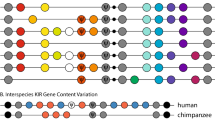Abstract.
Annexins provide an exemplary model for studying the pattern and process of molecular evolution in multigene families. Their related gene structures, broad dispersal in eukaryotic genomes and abundant coding sequences permit a phylogenetic reconstruction of their genetic history. The emerging picture is one of prolific expansion by gene duplication to more than 27 paralogous subfamilies that have undergone steady sequence divergence, speciation and differential selection. Homologous recombination via the common tetrad of internal repeats has, nevertheless, strictly preserved this core structure for over 1200 million years, implying a basic functional role. The existence of multiple annexins with unique 5′ coding and regulatory regions has facilitated their adaptation to the varying ontogenetic and cell-specific needs of diverse organisms. Computational and cladistic sequence analyses have permitted the determination of original gene duplication dates and mutation rates for the ten known vertebrate annexins. Molecular genetic and evolutionary studies of annexins can help to define their structure-function relationships, elucidate their individual physiological roles and ultimately link them to hereditary phenotypes.
Similar content being viewed by others
Author information
Authors and Affiliations
Rights and permissions
About this article
Cite this article
Morgan, R., Fernández, M. Annexin gene structures and molecular evolutionary genetics. CMLS, Cell. mol. life sci. 53, 508–515 (1997). https://doi.org/10.1007/s000180050064
Issue Date:
DOI: https://doi.org/10.1007/s000180050064




